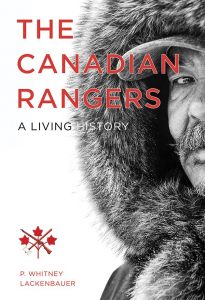In the 1950s any Soviet paratrooper who attempted to land in the Northwest Territories would have faced the Canadian Rangers, a crack team of marksmen assigned to wage guerrilla-style “hit and run” operations on the tundra.
The Russians never landed. By the laws of inertia, the Rangers remained. Historian P. Whitney Lackenbauer celebrates these Cold Warriors who never fired a shot in anger. Instead, they became a caricature.
“Clad in their red sweatshirts, they appeared regularly in media photographs,” Lackenbauer writes without irony; “Rangers greeted Queen Elizabeth II and Prince Philip when they arrived in Iqaluit to begin their Golden Jubilee visit. The Queen made particular note of the Rangers’ presence and told them how much she liked their uniforms.”
Professor Lackenbauer is a respected scholar. His difficulty is in chronicling members of an armed force whose military careers were never interrupted by combat. At one point he is reduced to telling the story of a Labrador Ranger who used icebergs for target practice.
The history of this odd force dates from 1947 when the first company was formed in Dawson City. The captain was a local storekeeper. In 1956 the Rangers’ strength peaked at 2725 men, mainly ex-cops, Inuit trappers and Hudson’s Bay clerks.
“Should an enemy ever advance over the Arctic barrens,” explained the Cold War-era Montreal Gazette, “the Ranger role would be hit-and-run operations to stall the invading force until Canada’s mobile striking force could be transported or parachuted into the area.”
The Rangers received neither pay nor training, but satisfied a romantic ideal: “They are a flexible, inexpensive and culturally inclusive means of having ‘boots on the ground’ to demonstrate sovereignty and to conduct or support domestic operations,” Lackenbauer writes.
Whatever military purpose was served by the Rangers vanished Oct. 4, 1957 with the Soviet launch of a 23-inch satellite Sputnik 600 miles into orbit. Now the Russians didn’t have to parachute into Dawson City. They could fling a missile overhead into Washington D.C.
Regardless, The Canadian Rangers is a celebration. “The Rangers’ basic mandate –‘to provide a military presence in sparsely settled northern, coastal and isolated areas of Canada that cannot conveniently or economically be provided for by other components of the Canadian Forces’– has remained remarkably consistent since 1947,” Lackenbauer writes.
Well, maybe.
Readers are told of the experience of John Sperry, an Anglican missionary who served as a Ranger lieutenant in Coppermine, NWT. Sperry received his commission in the mail and never held any meetings: “No one ever asked him to report on the number of Rangers in the platoon.” Captain Sperry’s only function was to sign up volunteers, hand them a government-issue rifle and distribute the annual ration of bullets.
The Rangers’ yearly ammunition budget was $8.35 per volunteer. It was a long fall from making the Arctic safe from the Soviets.
By Holly Doan
The Canadian Rangers: A Living History by P. Whitney Lackenbauer; UBC Press; 658 pages; ISBN 9780774824538; $34.95






